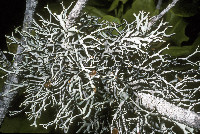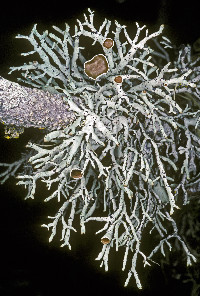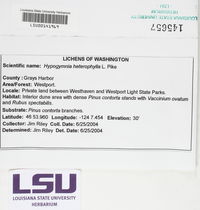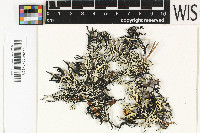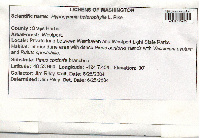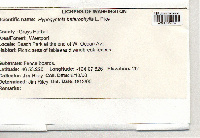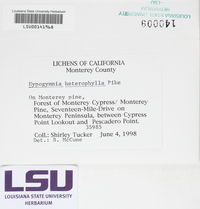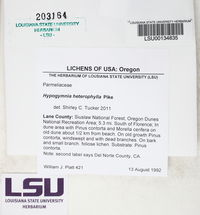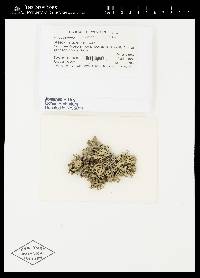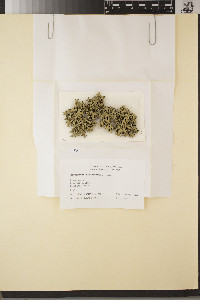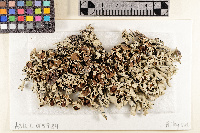
Consortium of Lichen Herbaria
- building a Global Consortium of Bryophytes and Lichens as keystones of cryptobiotic communities -
- Home
- Search
- Images
- Species Checklists
- US States: O-Z >
- US National Parks
- Central America
- South America
- US National Parks
- Southern Subpolar Region
|
|
|
|
Family: Parmeliaceae
|
Nash, T.H., Ryan, B.D., Gries, C., Bungartz, F., (eds.) 2002. Lichen Flora of the Greater Sonoran Desert Region. Vol 1. Thallus: erect or appressed, up to 9 (-15) cm broad; texture: cartilaginous; branching: variable, budding present lobes: separate to centrally contiguous, 1-3 (-4) mm wide, often black bordered; profile: even to ± nodulose; width/height ratio: 0.3-3; tips and axils: often perforate; holes usually developing slowly so that large holes are mainly axillary and the lobe tips have only pinholes upper surface: white to greenish gray, often dark mottled, smooth to rugose; soredia and isidia: lacking; lobules: sparse or lacking medulla: hollow, ceiling of cavity dark, floor of cavity dark lower surface: black, sparsely perforate Apothecia: common, substipitate to stipitate, up to 10 (-15) mm in diam; stipe: urn- or funnel-shaped, hollow; disc: brown ascospores: ellipsoid, 6-7 x 3.5-4 µm Pycnidia: common conidia: weakly bifusiform, 5-6 x 0.5-0.8 µm Spot tests: cortex K+ yellow, C-, KC-, P+ pale yellow, UV-; medulla K-, C-, KC+ orange-red, P+ orange-red Secondary metabolites: upper cortex with atranorin and chloroatranorin; medulla with physodic acid (major), physodalic acid (major), protocetraric acid (minor), unknown C7 (UV+, minor but constant), occasionally with unknown C10 (minor), rarely with 3-hydroxyphysodic acid. Substrate and ecology: on bark of conifers, less often on hardwoods World distribution: Pacific coast of North America, southern British Columbia to central California, always near the coast Sonoran distribution: rare disjuncts near the coast, south to Santa Barbara County and Santa Cruz Island. Notes: This species is rare in southern California but becomes common north of San Francisco along the coast. These southern populations usually have relatively small, compact thalli. Some forms with puffy lobes can be confused with H. enteromorpha, but the latter has broadly elliptical spores 4.5-6 µm wide versus elliptical spores 3.5-4 µm wide in H. heterophylla. They can also be distinguished by TLC, H. heterophylla never having diffractaic acid and always with the UV+ reddish unknowns (C7), while H. enteromorpha often contains diffractaic acid and never unknown C7. |
|
|
|
Powered by Symbiota





